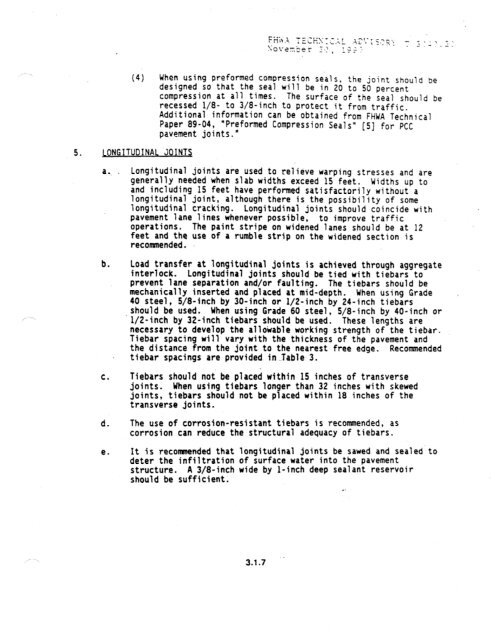chapter 3 rigid pavement - DOT On-Line Publications - Department ...
chapter 3 rigid pavement - DOT On-Line Publications - Department ...
chapter 3 rigid pavement - DOT On-Line Publications - Department ...
You also want an ePaper? Increase the reach of your titles
YUMPU automatically turns print PDFs into web optimized ePapers that Google loves.
(4) When using preformed compression seals, the joint should be<br />
designed so that the seal will be in 20 to 50 percent<br />
compression at all times. The surface of the seal should be<br />
recessed l/8- to 3/G-inch to protect it from traffic.<br />
Additional information can be obtained from FHWA Technical<br />
Paper 89-04, "Preformed Compression Seals" [S] for PCC<br />
<strong>pavement</strong> joints."<br />
5. LONGITUDINAL JOINTS<br />
b.<br />
C.<br />
d.<br />
e.<br />
. Longitudinal joints are used to relieve warping stresses and are<br />
generally needed when slab widths exceed 15 feet. Widths up to<br />
and including 15 feet have performed satisfactorily without a<br />
longitudinal joint, although there is the possibility of some<br />
longitudinal cracking. Longitudinal joints should coincide with<br />
<strong>pavement</strong> lane lines whenever possible, to improve traffic<br />
operations. The paint stripe on widened lanes should be at 12<br />
feet and the use of a rumble strip on the widened section is<br />
recommended.<br />
Load transfer at longitudinal joints is achieved through aggregate<br />
interlock. Longitudinal joints should be tied with tiebars to<br />
prevent lane separation and/or faulting. The tiebars should be<br />
mechanically inserted and placed at mid-depth. When using Grade<br />
40 steel, S/8-inch by SO-inch or l/2-inch by 24-inch tiebars<br />
should be used. When using Grade 60 steel, S/8-inch by 40-inch or<br />
l/2-inch by 32-inch tiebars should be used. These lengths are<br />
necessary to develop the allowable working strength of the tiebar.<br />
Tiebar spacing will vary with the thickness of the <strong>pavement</strong> and<br />
the distance from the joint to the nearest free edge. Recommended<br />
tiebar spacings are provided in..Table 3.<br />
Tiebars should not be placed within 15 inches of transverse<br />
joints. When using tiebars longer than 32 inches with skewed<br />
joints, tiebars should not be placed within 18 inches of the<br />
transverse joints.<br />
The use of corrosion-resistant tiebars is recommended, as<br />
corrosion can reduce the structural adequacy of tiebars.<br />
It is recommended that longitudinal joints be sawed and sealed'to<br />
deter the infiltration of surface water into the <strong>pavement</strong><br />
structure. A 3/&inch wide by l-inch deep sealant reservoir<br />
should be sufficient.<br />
3.1.7 ”
















